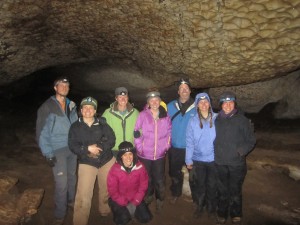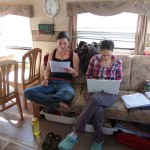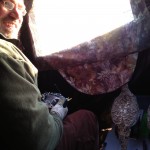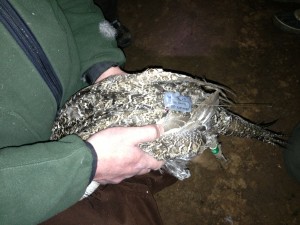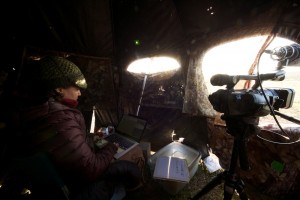(note- I began writing this entry in the first week in May but finally had time to finish and post it today).
Our wonderful field crew departed yesterday (thank you again Elena, Kate, Christa, Max, and Hannah! You guys were fantastic!), which leaves Gail, Anna and I to finish up things in the field, pack up the camp, and look back on our 2013 field season.
The end of our time in Wyoming always involves proofing data– teams of two people check each line of data in the computer against the field notes to look for typos and other problems. No matter how conscientious one is, mistakes always creep in (especially when one gets up at 4 in the morning!) Reading each line aloud and filtering data to make sure there are no o’s masquerading as zeros for example, are important ways to insure data quality.
In some respects it was a disappointing season, with some of the least cooperative weather we’ve ever encountered. We had repeated cycles of snow every week or two that delayed or prevented meeting some of our field goals. We didn’t have time at the end of the season to run the full suite of robot experiments that we wanted to, so those will be saved for another year. We also didn’t get our sage chemical sampling in, although this was partly a data quality concern (since the sage are producing their ephemeral “summer” leaves now, our results wouldn’t tell us as much about grouse foraging in the late winter and early spring).
We did tick off a few important objectives though. Gail’s redesign of the robots work great- in our tests on the lek they looked good and we didn’t have to mount any “rescues” due to tipping over. Our crew were instrumental in developing several new protocols ready for next year- including sage sampling, computer-assisted sorting of tail feather “buttprint” photos and moving to a free-ware image analysis program for making those buttprints.
We also got a lot of interesting data from a “bad” year, so we can take a closer look at how environmental variation affects the grouse. Our birds endured a drought; population numbers were really down not only from the high years of 2006 & 2007, but even from last year, so this could have an interesting impact on male traits and behaviors as well as what females like. As Peter and Rosemary Grant showed with their seminal work on Darwin’s Finches in the Galapagos, sometimes you only notice strong selection when times get tough.
As an exciting finale, we finally got two of our new Encounternet telemetry tags, and with Kurt Smith (Ph.D. candidate from the University of Wyoming who is studying Sage-Grouse just southeast from our site), managed to get them on two males from Cottontail.
After our capture success, we visited Cottontail every morning until our departure to try and test out these new tags. One of our tagged males (male number 641, later called “Talon Krakauer” by our crew), came back to his old territory. We’ll give Kurt a lot of credit for Talon’s return. In our fairly limited experience, birds caught towards the end of the season tend not to return to the lek that season and wait until the next year to strut their stuff. Kurt has put VHF and GPS tags on well over 100 sage-grouse now, so has a good handle on how to make sure the capture and harnessing is as minimally disruptive as possible.
From a blind 40 meters from Talon’s territory, we were able to communicate remotely with Talon’s tag, switch it from the low power mode that that would allow the battery to last until next season to the “streaming” mode that would send real-time accelerometer data from the grouse to our receiver. At the same time we were able to videotape Talon’s behavior. In this way we can correlate the behavior with the movement data coming from the tag. When the birds started looking nervous like they were going to depart the lek for the day, we were able to switch the tag back into the power-saving mode. The GPS sensor on the tag will now come to life every 2 days to take a waypoint, and if all goes well, we will be able to download these points next year and see where Talon ventured throughout the summer and fall.
We will likely do further tests of the accelerometer sensor with chickens back on campus, but we feel much better having some data from an actual sage-grouse in hand.

